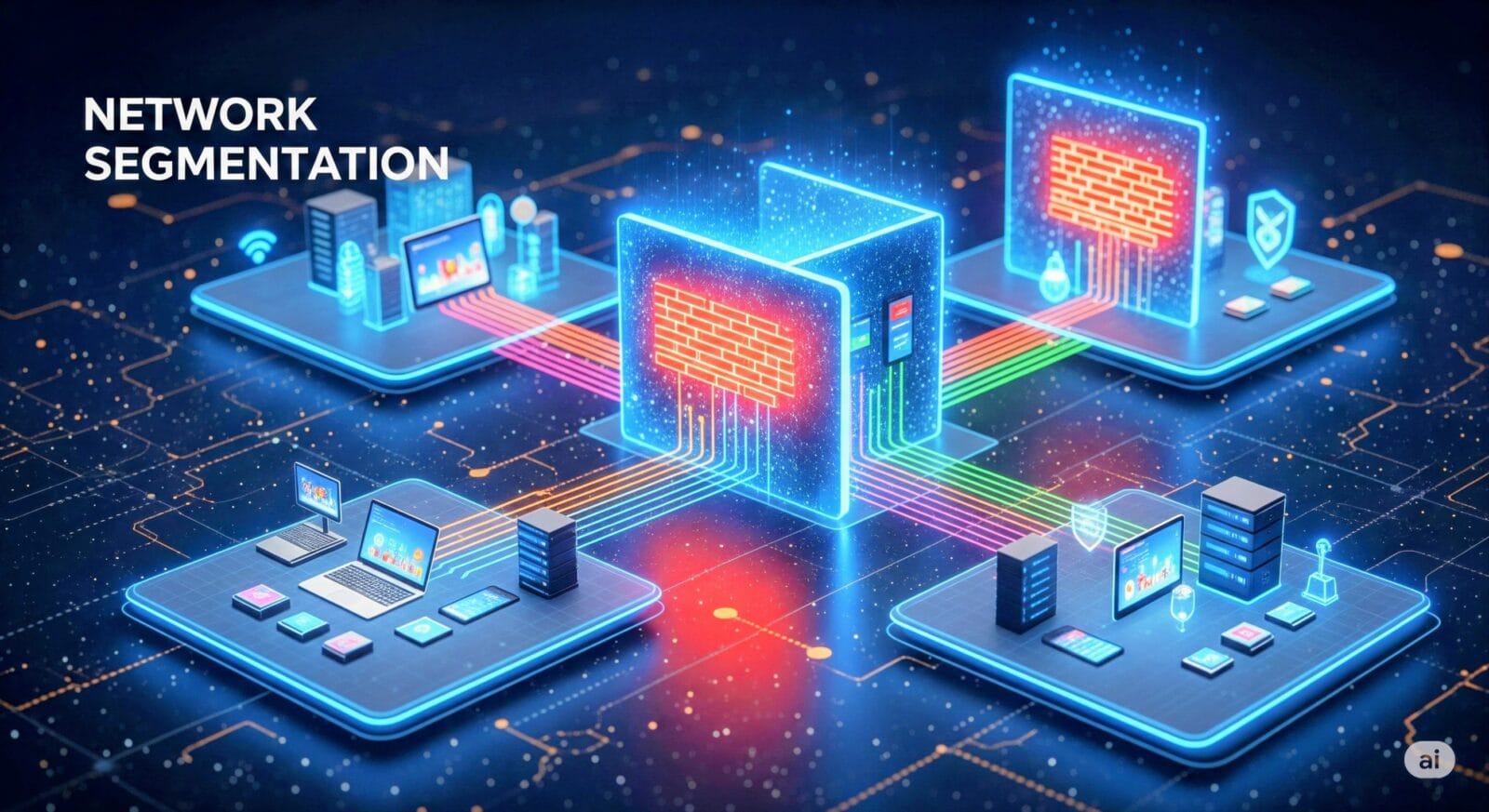In today’s threat landscape, assuming your internal network is secure just because it sits behind a firewall is a dangerous fallacy. Cybercriminals are not just breaching networks—they’re moving laterally, escalating privileges, and exfiltrating data with surgical precision.
This is where network segmentation steps in—not just as a best practice, but as a critical defence mechanism in modern cybersecurity.
In this article, we’ll break down the importance of network segmentation, how it strengthens your security posture, and what steps your organisation should take to implement it effectively.
What is Network Segmentation?
Network segmentation is the practice of dividing a computer network into multiple subnetworks (or segments) to control and limit the flow of traffic between them.
Instead of one flat network where any device can talk to any other, segmentation creates logical barriers—reducing the attack surface, limiting lateral movement, and improving visibility.
For example:
- HR systems don’t need to communicate with your industrial control systems.
- Guest Wi-Fi shouldn’t access internal file servers.
- Developers shouldn’t have direct access to production databases.
📌 Think of segmentation as the “compartmentalisation” of your digital infrastructure. If one room catches fire, the whole building doesn’t burn down.
Why is Network Segmentation Important?
Here’s why it’s become a non-negotiable control for any security-conscious organisation:
1. Limits Lateral Movement in Cyber Attacks
Once inside a flat network, attackers can scan and move freely. With segmentation in place, they hit access controls that prevent them from pivoting.
🛡️ Real-world case: During the Target data breach, attackers gained access through HVAC systems and moved laterally to the POS network. Proper segmentation could’ve stopped this jump.
2. Supports Zero Trust Security Models
Zero Trust assumes “never trust, always verify”—and network segmentation is central to that approach.
By enforcing least privilege and microsegmentation, you can tightly control which users and devices access which resources. Learn more in NIST’s Zero Trust Architecture framework.
3. Improves Incident Containment and Response
When a breach occurs, segmentation helps contain the blast radius. Malware can’t propagate across segments without crossing additional controls—buying valuable time for detection and response.
Combine segmentation with EDR and SIEM tools, and you gain faster forensic insights into where, how, and when the attack happened.
4. Regulatory Compliance and Data Protection
Many regulations—including PCI-DSS, HIPAA, and GDPR—require controlled access to sensitive data. Segmentation makes it easier to isolate regulated systems and demonstrate compliance.
💡 For example, under PCI-DSS, the cardholder data environment (CDE) must be isolated from the rest of the enterprise network.
5. Enhanced Performance and Traffic Management
Segmentation also reduces broadcast traffic and congestion by keeping data flows local. This translates to better performance, reduced latency, and improved bandwidth management across departments or environments.
Types of Network Segmentation
Network segmentation can be done at various levels:
| Type | Description |
|---|---|
| Physical Segmentation | Uses separate hardware—switches, routers—for complete isolation. |
| Virtual LANs (VLANs) | Logical segmentation on the same physical infrastructure using switches. |
| Firewall-Based Segmentation | Uses access control lists (ACLs) or zone-based firewalls to control traffic. |
| Microsegmentation | Granular, identity-based segmentation typically at the application or workload level. Often seen in cloud environments. |
Each approach has its use case. Most modern environments use a hybrid model, combining VLANs and firewall rules with microsegmentation in cloud workloads.
Best Practices for Implementing Network Segmentation
Here’s how to implement segmentation without causing operational friction:
✅ 1. Identify and Classify Assets
Start by mapping your network and classifying assets by sensitivity, criticality, and risk. Tools like Nmap, SolarWinds Network Topology Mapper, or agent-based scanning can help.
✅ 2. Define Clear Segmentation Policies
Establish who or what can access each segment. Use role-based and context-based policies where possible.
✅ 3. Implement Access Controls
Use firewalls, ACLs, and identity-based access management to enforce policies. Leverage Cisco’s segmentation guidance or Palo Alto Networks’ microsegmentation tools if operating at scale.
✅ 4. Monitor East-West Traffic
Use network traffic analysis (NTA) or IDS/IPS systems to observe traffic within your internal segments (not just perimeter traffic).
✅ 5. Test and Validate Regularly
Penetration testing and red teaming exercises will expose any misconfigurations or gaps in your segmentation strategy.
Common Pitfalls to Avoid
- 🚫 Over-segmentation: Creates operational complexity and increases administrative overhead.
- 🚫 Assuming VLANs alone provide security: VLANs without access controls are not secure.
- 🚫 Neglecting cloud workloads: Segmenting on-prem but ignoring cloud or hybrid environments creates blind spots.
- 🚫 Static rules without context: Today’s attacks are dynamic. Use context-aware access and adaptive segmentation.
Conclusion: Network Segmentation is Not Optional
In a world of persistent threats, insider risks, and supply chain compromises, flat networks are liabilities.
Network segmentation enables you to:
- Minimise lateral movement
- Enforce least privilege access
- Contain breaches more effectively
- Align with Zero Trust principles
- Meet regulatory compliance requirements
🔒 It’s not just about stopping breaches—it’s about limiting their impact.
Frequently Asked Questions (FAQs)
Q1: Is VLAN the same as network segmentation?
No. VLANs offer logical separation, but without access controls, they’re not inherently secure. True segmentation includes policy enforcement.
Q2: What is the difference between segmentation and microsegmentation?
Traditional segmentation separates networks or zones. Microsegmentation applies at the application or workload level, often using identity-based access control.
Q3: Do I need segmentation in the cloud?
Absolutely. Cloud environments are dynamic and vulnerable. Use tools like AWS Security Groups or Azure NSGs to segment workloads and limit access.

















Leave a comment